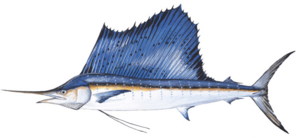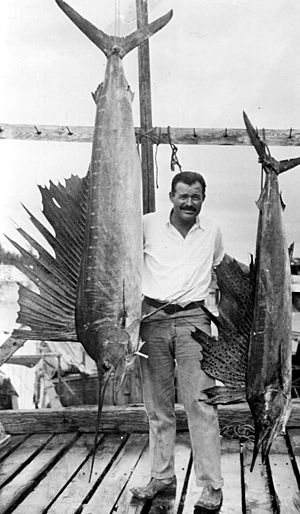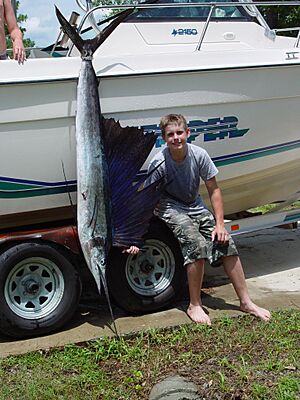Atlantic sailfish facts for kids
Quick facts for kids Atlantic sailfish |
|
|---|---|
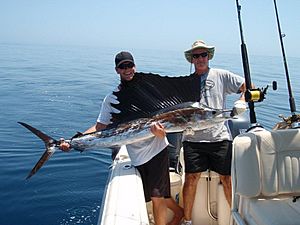 |
|
| Two men holding a freshly caught Atlantic sailfish | |
| Scientific classification |
|
| Kingdom: | Animalia |
| Phylum: | Chordata |
| Class: | Actinopterygii |
| Order: | Istiophoriformes |
| Family: | Istiophoridae |
| Genus: | Istiophorus |
| Species: |
I. albicans
|
| Binomial name | |
| Istiophorus albicans (Latreille, 1804)
|
|
The Atlantic sailfish (Istiophorus albicans) is a super cool marine fish. It belongs to the same family as the marlin. You can find this amazing creature in the Atlantic Ocean and the Caribbean Sea. It swims near the surface but can dive down to about 200 m (656 ft).
Sailfish are known for being incredibly fast swimmers! They are alo skilled hunters. They mostly eat groups of fish like sardines, anchovies, and mackerel. They also enjoy munching on crustaceans and cephalopods like squid.
Contents
Description and Appearance
The Atlantic sailfish is dark bluish-black on its upper parts, which helps it blend in with the darker depths when viewed from above. Its sides are lighter, often with about twenty striking bluish horizontal bars running along its flanks. Its underparts are a silvery white, a clever camouflage technique called "counter-shading." This means that when viewed from below, its light belly blends with the bright surface light, making it harder for predators or prey to spot.
The most famous feature is, of course, its enormous dorsal fin, which stretches almost the entire length of its back and stands tall like a ship's sail. This fin is typically bluish-black and speckled with small black spots, adding to its unique beauty. When swimming at high speeds, the sail can be folded down into a groove on its back, making the fish even more hydrodynamic.
Another prominent feature is its long, pointed, bill-like snout, or rostrum. This isn't just a nose; it's a specialized tool! While its exact adaptive advantages have been debated, it's well-documented that the sailfish uses this bill for hunting.
Its tail fin is strongly forked, a classic design for fast-swimming fish, providing powerful propulsion. The other fins, including the anal fins (which have pale bases), are also bluish-black, completing its elegant look.
Size and Weight
An Atlantic sailfish can reach lengths of up to 3.15 meters (that's over 10 feet, longer than many cars!) and can weigh up to 58.1 kilograms (around 128 pounds).
Speed
The Atlantic sailfish is renowned for its incredible speed, making it one of the fastest fish in the ocean. While early tests in the 1920s suggested speeds of up to 111 kilometers per hour (69 mph) in short bursts, more recent and conservative estimates place their top speeds between 37 to 55 kilometers per hour (23 to 34 mph). Some very recent studies even suggest their maximum swimming speed might be closer to 36 km/h (22 mph).
Regardless of the exact number, they are undeniably swift and agile predators!
Hunting and Diet
Sailfish are expert hunters, often working together in groups to corner their prey. They primarily hunt schooling fish, which means fish that swim together in large groups, like sardines, anchovies, and mackerel. They also enjoy a varied diet that includes crustaceans (like crabs and shrimp) and cephalopods (like squid and octopus).
When hunting, sailfish rely on a combination of stealth and quick, precise movements. They'll often approach a school of fish, then use their long, pointed bill to slash or tap individual fish. This action temporarily stuns or disorients the prey, making it much easier for the sailfish to then turn around and swallow it. It's a highly effective and specialized hunting technique! The bill isn't used to spear or impale, but rather as a precision tool for incapacitating prey.
Sometimes, sailfish will cooperate, forming a "hunting pack" to herd schools of fish into a tight ball, making it easier for each individual to take turns slashing and feeding. This teamwork is a fascinating example of complex behavior in marine life.
Distribution and Habitat
The Atlantic sailfish is a pelagic fish, which means it lives in the open ocean, away from the coast and the seabed. It prefers the warm, tropical, and temperate waters of the Atlantic Ocean.
- Geographic Range: You can find Atlantic sailfish across a vast area of the Atlantic. In the northwestern Atlantic, they range as far north as approximately 40°N latitude (around the latitude of New York City in the USA). In the southwestern Atlantic, they extend south to about 40°S latitude (around the latitude of southern Argentina). In the northeastern Atlantic, they can be found up to 50°N (around the latitude of the UK), and in the southeastern Atlantic, down to 32°S (around the latitude of South Africa).
- Depth: While they are often seen near the surface, especially when hunting, Atlantic sailfish can dive to depths of about 200 meters (that's about 656 feet!). This allows them to access different food sources and escape predators if needed. They thrive in warm surface waters, which is why they are found in tropical and temperate zones.
Migration
These fish are true ocean travelers! They are a migratory species, constantly moving across the open ocean in search of food and suitable breeding grounds. They even venture into the Mediterranean Sea, showing their incredible adaptability to different parts of the ocean.
Taxonomy
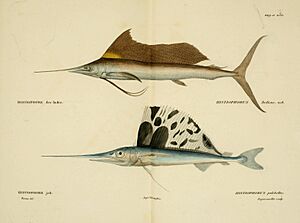
Taxonomy is the science of classifying living things into groups based on their shared characteristics. It helps us understand how different species are related to each other.
- Scientific Name: The Atlantic sailfish's scientific name is 'Istiophorus albicans'. The genus name, Istiophorus, comes from Greek words meaning "sail-bearer," which perfectly describes its most prominent feature!
- Family: It belongs to the family Istiophoridae, which includes other billfish like marlins and spearfish. This family is known for its members having long, pointed bills and being fast, predatory ocean dwellers.
Interestingly, there's a bit of a debate among scientists about whether there are one or two species of sailfish. Some authorities recognize only a single global species, Istiophorus platypterus, and consider I. albicans (the Atlantic sailfish) to be just a variation or synonym of I. platypterus. Other scientists believe there are indeed two distinct species: the Atlantic sailfish (I. albicans) and the Indo-Pacific sailfish (I. platypterus). This kind of scientific discussion is common as researchers gather more genetic and observational data to better understand the relationships between different populations of animals. For now, we often refer to the Atlantic sailfish as Istiophorus albicans when specifically talking about the one found in the Atlantic.
Conservation
The Atlantic sailfish is currently classified as a species of "Least Concern" on the IUCN Red List of Threatened Species. This global assessment means that, for now, the species is not considered to be facing a high risk of extinction.
Major Threats
Atlantic sailfish face several serious human-induced threats:
- Bycatch in Commercial Fisheries: This is the single biggest threat. Sailfish are frequently caught accidentally as bycatch in pelagic (open ocean) longline fisheries targeting tuna and swordfish. While some are released, the mortality rate is high due to the physical stress of capture and injury from hooks.
- Drift Gillnet Fisheries: In some areas, these indiscriminate nets are a major source of mortality, often catching and killing sailfish along with many other non-target species.
- Directed Recreational Fisheries: Sailfish are one of the most prized catches in big-game sport fishing due to their spectacular leaps and fighting ability. While the modern sport fishing ethic heavily emphasizes "catch-and-release", mortality can still occur. Factors like fight time, handling, and hook placement affect whether a released fish will survive.
- Overfishing of Prey Species: Sailfish primarily eat small fish and squid. The overfishing of these forage fish can disrupt the marine food web and impact sailfish nutrition and populations.
- Habitat Degradation and Climate Change: Changes in ocean temperature, chemistry, and currents can affect the distribution of sailfish and their prey. Pollution, especially plastic debris, is also a concern in their pelagic environment.
Cool facts about the Atlantic sailfish
- Despite their size and speed, sailfish generally have a relatively short lifespan, typically living for about 4 to 5 years. This means they grow quickly and reproduce early in their lives.
- Their sail isn't just for hunting or looking cool! Scientists believe it also plays a role in thermoregulation, which means helping the sailfish control its body temperature.
- Sailfish are highly prized by sport fishermen. This has led to conservation efforts to ensure their populations remain healthy and sustainable for future generations. Many fishing tournaments promote "catch and release" practices to protect these magnificent creatures.
- They are among the fastest-growing fish in the ocean. They can grow from a tiny larva to a meter-long fish in just one year! This rapid growth is essential for a species that needs to reach a large size quickly to become an effective predator.
- Sailfish have special sensory pits on their heads that help them detect vibrations and movements in the water. This gives them an advantage when locating prey, especially in murky conditions or at night.
See also
 In Spanish: Pez vela del Atlántico para niños
In Spanish: Pez vela del Atlántico para niños


